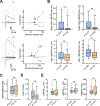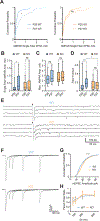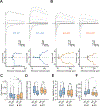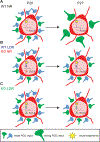Visual Experience-Dependent Expression of Fn14 Is Required for Retinogeniculate Refinement
- PMID: 30033152
- PMCID: PMC6101651
- DOI: 10.1016/j.neuron.2018.06.036
Visual Experience-Dependent Expression of Fn14 Is Required for Retinogeniculate Refinement
Abstract
Sensory experience influences the establishment of neural connectivity through molecular mechanisms that remain unclear. Here, we employ single-nucleus RNA sequencing to investigate the contribution of sensory-driven gene expression to synaptic refinement in the dorsal lateral geniculate nucleus of the thalamus, a region of the brain that processes visual information. We find that visual experience induces the expression of the cytokine receptor Fn14 in excitatory thalamocortical neurons. By combining electrophysiological and structural techniques, we show that Fn14 is dispensable for early phases of refinement mediated by spontaneous activity but that Fn14 is essential for refinement during a later, experience-dependent period of development. Refinement deficits in mice lacking Fn14 are associated with functionally weaker and structurally smaller retinogeniculate inputs, indicating that Fn14 mediates both functional and anatomical rearrangements in response to sensory experience. These findings identify Fn14 as a molecular link between sensory-driven gene expression and vision-sensitive refinement in the brain.
Keywords: LGN; lateral geniculate nucleus; retinogeniculate; single-cell; single-nucleus; synapse; synapse elimination; synaptic refinement; visual thalamus.
Copyright © 2018 Elsevier Inc. All rights reserved.
Figures








Similar articles
-
Refinement of Spatial Receptive Fields in the Developing Mouse Lateral Geniculate Nucleus Is Coordinated with Excitatory and Inhibitory Remodeling.J Neurosci. 2018 May 9;38(19):4531-4542. doi: 10.1523/JNEUROSCI.2857-17.2018. Epub 2018 Apr 16. J Neurosci. 2018. PMID: 29661964 Free PMC article.
-
Changes in input strength and number are driven by distinct mechanisms at the retinogeniculate synapse.J Neurophysiol. 2014 Aug 15;112(4):942-50. doi: 10.1152/jn.00175.2014. Epub 2014 May 21. J Neurophysiol. 2014. PMID: 24848465 Free PMC article.
-
Sensory Experience Engages Microglia to Shape Neural Connectivity through a Non-Phagocytic Mechanism.Neuron. 2020 Nov 11;108(3):451-468.e9. doi: 10.1016/j.neuron.2020.08.002. Epub 2020 Sep 14. Neuron. 2020. PMID: 32931754 Free PMC article.
-
Organization, Function, and Development of the Mouse Retinogeniculate Synapse.Annu Rev Vis Sci. 2020 Sep 15;6:261-285. doi: 10.1146/annurev-vision-121219-081753. Annu Rev Vis Sci. 2020. PMID: 32936733 Review.
-
Refinement of the retinogeniculate pathway.J Physiol. 2008 Sep 15;586(18):4357-62. doi: 10.1113/jphysiol.2008.157115. Epub 2008 Jun 12. J Physiol. 2008. PMID: 18556365 Free PMC article. Review.
Cited by
-
The TWEAK/Fn14/CD163 axis-implications for metabolic disease.Rev Endocr Metab Disord. 2022 Jun;23(3):449-462. doi: 10.1007/s11154-021-09688-4. Epub 2021 Sep 20. Rev Endocr Metab Disord. 2022. PMID: 34542797 Free PMC article. Review.
-
Movers and shakers: Microglial dynamics and modulation of neural networks.Glia. 2023 Jul;71(7):1575-1591. doi: 10.1002/glia.24323. Epub 2022 Dec 19. Glia. 2023. PMID: 36533844 Free PMC article. Review.
-
Glial modulation of synapse development and plasticity: oligodendrocyte precursor cells as a new player in the synaptic quintet.Front Cell Dev Biol. 2024 Aug 27;12:1418100. doi: 10.3389/fcell.2024.1418100. eCollection 2024. Front Cell Dev Biol. 2024. PMID: 39258226 Free PMC article. Review.
-
Activity-dependent transcriptional programs in memory regulate motor recovery after stroke.Commun Biol. 2024 Aug 25;7(1):1048. doi: 10.1038/s42003-024-06723-3. Commun Biol. 2024. PMID: 39183218 Free PMC article.
-
Phospholipid-flippase chaperone CDC50A is required for synapse maintenance by regulating phosphatidylserine exposure.EMBO J. 2021 Nov 2;40(21):e107915. doi: 10.15252/embj.2021107915. Epub 2021 Sep 29. EMBO J. 2021. PMID: 34585770 Free PMC article.
References
Publication types
MeSH terms
Substances
Grants and funding
LinkOut - more resources
Full Text Sources
Other Literature Sources
Molecular Biology Databases

